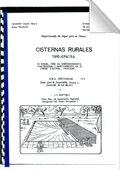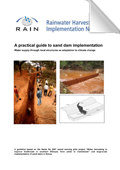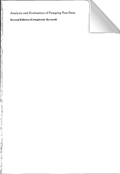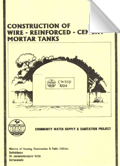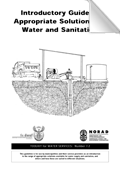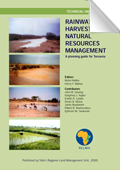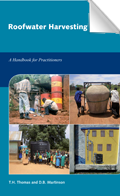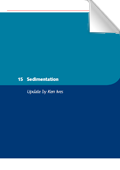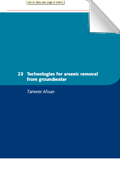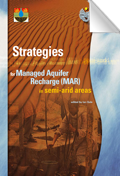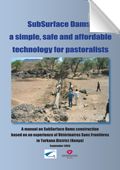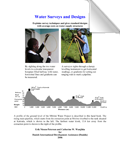
Filter by category
Or search
Loading search form...
Explanation
SamSamWater makes information on water and sanitation easy to find and accessible for all. This page contains a database with practical information, data and (GIS)maps.
We believe information should be shared to make water and sanitation projects more successful. The information in the database is gathered from numerous sources, such as research institutes, companies, NGOs and government organisations.
Do you have information we can integrate into this database, or if you have comments or questions, please contact us!
57 items found within the categories:
Technology and techniques
Clear search filter.
Erik Nissen-Petersen, ASAL Consultants Ltd. (2011)
Erik Nissen-Petersen, ASAL Consultants Ltd. (2011)
E.H. Hofkes and J.T. Visscher, International Reference Centre for Community Water Supply and Sanitation The Hague, The Netherlands (1986)
A.W.A. Oosterbaan & J.V. Martinez, Departemento de Ague para el Chaco (1987)
RAIN Foundation, RAIN Foundation ()
G.P. Kruseman, N.A. de Ridder, ILRI (1994)
Neil Herath, Comminity Water Supply & Sanitation Project (CWSSP), Ministry of Housing, Construction & Public Utilities, Sri Lanka (1995)
M.G. Bos, ILRI (1989)
H.P. Ritzema, ILRI (1994)
Richard Holden, Tania Swanepoel, DWAF (2004)
NWP, NWP (2006)
Kithinji Mutunga, Will Critchley, Sida's Regional Land Management Unit (2002)
ERHA, RAIN Foundation, ()
Nuhu Hatibu, Henry F. Mahoo, Sida's Regional Land Management Unit (2000)
T.H. Thomas, D.B. Martinson, IRC (2007)
Jo Smet, Christine van Wijk, IRC (2002)
Jo Smet, Christine van Wijk, IRC (2002)
Jo Smet, Christine van Wijk, IRC (2002)
Jo Smet, Christine van Wijk, IRC (2002)
Jo Smet, Christine van Wijk, IRC (2002)
Jo Smet, Christine van Wijk, IRC (2002)
Jo Smet, Christine van Wijk, IRC (2002)
Jo Smet, Christine van Wijk, IRC (2002)
Jo Smet, Christine van Wijk, IRC (2002)
Jo Smet, Christine van Wijk, IRC (2002)
Jo Smet, Christine van Wijk, IRC (2002)
Jo Smet, Christine van Wijk, IRC (2002)
Jo Smet, Christine van Wijk, IRC (2002)
Jo Smet, Christine van Wijk, IRC (2002)
Jo Smet, Christine van Wijk, IRC (2002)
Jo Smet, Christine van Wijk, IRC (2002)
Jo Smet, Christine van Wijk, IRC (2002)
Jo Smet, Christine van Wijk, IRC (2002)
Jo Smet, Christine van Wijk, IRC (2002)
Jo Smet, Christine van Wijk, IRC (2002)
NWP, NWP (2010)
NWP, NWP (2006)
NWP, NWP (2007)
NWP, NWP (2006)
NWP, NWP (2006)
NWP, NWP (2006)
Ian Gale, UNESCO International Hydrological Programme, IAH (2005)
VSF-Belgium, VSF-Belgium (2006)
WaterAid, WaterAid (2007)
Marloes L. Mul, CRC Press/Balkema (2009)
Erik Nissen-Petersen, Birgit Madsen, Munguti Katui-Katua, DANIDA (2006)
Erik Nissen-Petersen, DANIDA (2006)
Erik Nissen-Petersen, DANIDA (2006)
Erik Nissen-Petersen, DANIDA (2006)
Erik Nissen-Petersen, DANIDA (2006)
Erik Nissen-Petersen, WEDC Conference (1997)
Erik Nissen-Petersen, DANIDA (2006)
Erik Nissen-Petersen, DANIDA (2006)
Technology and techniques
Clear search filter.
Sand dams or silt traps?
Erik Nissen-Petersen, ASAL Consultants Ltd. (2011)
It has been known from the African Land Development Project (ALDEV) since the late 1950s, that the spillways of sand dams must be raised in stages not exceeding a height of 50 cm in order
for floods to deposit coarse sand from where most water can be extracted. If a spillway is not built in stages, then silt will be deposited instead of sand and very little water, if any, can be
extracted from such a sand dam - or is it a silt trap? (source)
Serie:
Water for Arid Lands (all items in this serie)
Categories:
Technology and techniques
Groundwater hydrology
Water for Arid Lands (all items in this serie)
Categories:
Technology and techniques
Groundwater hydrology
Subsurface dams built of soil
Erik Nissen-Petersen, ASAL Consultants Ltd. (2011)
Paper on subsurface dams, their benefits and practical experiences with the planning, design and construction of subsurface dams. (source)
Serie:
Water for Arid Lands (all items in this serie)
Categories:
Technology and techniques
Rainwater harvesting
Groundwater hydrology
Water for Arid Lands (all items in this serie)
Categories:
Technology and techniques
Rainwater harvesting
Groundwater hydrology
Artificial groundwater recharge for water supply of medium-size communities in developing countries
E.H. Hofkes and J.T. Visscher, International Reference Centre for Community Water Supply and Sanitation The Hague, The Netherlands (1986)
This document integrates material selected from many sources, both published and unpublished. The focus is on potential application of artificial groundwater recharge for water supply of medium-size communities.
The purpose of this document is to provide planners and engineers with practical information to assess the potential for application of artificial groundwater recharge schemes in rural water supply programmes or projects. (source)
The purpose of this document is to provide planners and engineers with practical information to assess the potential for application of artificial groundwater recharge schemes in rural water supply programmes or projects. (source)
Cisternas rurales
A.W.A. Oosterbaan & J.V. Martinez, Departemento de Ague para el Chaco (1987)
Un manual para su dimensionamiento construction, y mantenimiento en el chaco central, Paraguay. (source)
A practical guide to sand dam implementation
RAIN Foundation, RAIN Foundation ()
Water supply through local structures as adaptation to climage change (source)
Akvopedia from Akvo.org
Wikipedia-like knowledgebase on water and sanitation. Contains many useful smart and affordable technical solutions and effective approaches.
Analysis and Evaluation of Pumping Test Data
G.P. Kruseman, N.A. de Ridder, ILRI (1994)
A reference book on aquifer test analyses methods. The first chapter summarizes the basic concepts and definitions of terms relevant to the subject. The next chapter describes how to conduct a pumping test. The remaining chapters deal with the analysis and evaluation of pumping test data from a variety of aquifer types or aquifer systems, and from tests conducted under particular technical conditions. (source)
Serie:
ILRI Publication 47 (all items in this serie)
Categories:
Technology and techniques
Groundwater hydrology
ILRI Publication 47 (all items in this serie)
Categories:
Technology and techniques
Groundwater hydrology
Appropedia
Wikipedia-like knowledgebase on collaborative solutions in sustainability, poverty reduction and international development. Including sections on Water and Health.
Construction of wire-reinforced cement mortar tanks
Neil Herath, Comminity Water Supply & Sanitation Project (CWSSP), Ministry of Housing, Construction & Public Utilities, Sri Lanka (1995)
this document has been scanned from earlier manuals and standardizations prepared by Neil Herath for CWSSP – Sri Lanka ( April 1995), and as Manual 3 of the Technical Manual Series on Rural Water Supply and Sanitation, Gravity Water Supply Systems: design and construction (January 2005). It is redesigned to look like the 2005 CWSSP manual guiding field work on wirereinforced cement mortar tanks, commonly known as ferrocement tanks (Han Heijnen, October 2010) (source)
Discharge measurement structures
M.G. Bos, ILRI (1989)
A handbook that presents instructions, standards, and procedures for the selection, design, and use of structures, which measure or regulate the flow rate in open channels. (source)
Serie:
ILRI Publication 20 (all items in this serie)
Categories:
Technology and techniques
Surface water hydrology
ILRI Publication 20 (all items in this serie)
Categories:
Technology and techniques
Surface water hydrology
Drainage Principles and Applications
H.P. Ritzema, ILRI (1994)
A handbook with discussions and aspects on drainage systems (source)
Serie:
ILRI Publication 16 (all items in this serie)
Categories:
Technology and techniques
Groundwater hydrology
ILRI Publication 16 (all items in this serie)
Categories:
Technology and techniques
Groundwater hydrology
Introductory Guide to Appropriate Solutions for Water and Sanitation
Richard Holden, Tania Swanepoel, DWAF (2004)
This guideline is for use by municipalities and their service providers as an introduction to the range of appropriate solutions available for water supply and sanitation, and where and how these are suited to different situations. (source)
l'Eau: des Solutions Simples et Économiques
NWP, NWP (2006)
Cette brochure sur l’eau, comme sa contrepartie ‘Des Solutions intelligentes pour l’assainissement’ (Smart Sanitation Solutions), relate des exemples d’innovations à petite échelle telles que la désinfection solaire de l’eau, l’emploi de filtres à eau efficaces et peu coûteux, le recours à l’irrigation goutte à goutte à bas-coût et l’utilisation de pompes manuelles fabriquées localement et cinq fois moins chères que les pompes importées. En adoptant ces technologies, les foyers défavorisés dans les zones rurales peuvent doubler, voire tripler leur revenu annuel.
Les solutions à petite échelle ont montré qu’elles pouvaient être économiquement rentables. Installées en grand nombre, elles peuvent à la fois améliorer la santé publique, relancer la production agricole et générer des activités locales. C’est pourquoi la diffusion à grande échelle de ces technologies est essentielle. (source)
Serie:
Smart water solutions (all items in this serie)
Categories:
Technology and techniques
Water quality, treatment and purification
Smart water solutions (all items in this serie)
Categories:
Technology and techniques
Water quality, treatment and purification
Low-cost methods of rainwater storage; Results from field trials in Ethiopia and Kenya
Kithinji Mutunga, Will Critchley, Sida's Regional Land Management Unit (2002)
Rainwater harvesting is one solution to the problems of water shortage in the drier areas of Africa, but its implementation presents a number of challenges, of which storage is the main one. Many people in rural areas who would like to harvest rainwater lack the resources to do so. Conventional stone, brick or ferrocement tanks are costly, and therefore there is a great need for cheaper alternatives. This publication gives an account of two trials conducted in 1998/99 to investigate some such alternatives. In Ethiopia, five different methods of tank construction were tested in the suburbs of Nazareth town in Adama Woreda. In Kenya, six different methods were tested during the same period at various locations in Machakos and Makueni Districts. A main feature of the alternative tank designs is that they are built underground, which reduces the need for reinforcement materials. (source)
Serie:
RELMA Technical Handbook Series No. 28 (all items in this serie)
Categories:
Technology and techniques
Rainwater harvesting
Roofwater harvesting
RELMA Technical Handbook Series No. 28 (all items in this serie)
Categories:
Technology and techniques
Rainwater harvesting
Roofwater harvesting
Manual on Sand Dams in Ethiopia
ERHA, RAIN Foundation, ()
A practical approach on sand dam site selection, design and construction. A tool for combining sand dams with other rainwater harvesting structures. (source)
Rainwater harvesting for natural resources management; A planning guide for Tanzania
Nuhu Hatibu, Henry F. Mahoo, Sida's Regional Land Management Unit (2000)
A planning handbook that provides planners with practical tips on how rainwater harvesting can form an integrated part of district development efforts. The book also gives practical guidelines in the planning steps required to incorporate rainwater harvesting in development plans, and shows how to implement them in the farmers’ context. (source)
Serie:
RELMA Technical Handbook Series No. 22 (all items in this serie)
Categories:
Technology and techniques
Rainwater harvesting
Roofwater harvesting
Infiltration and artificial recharge
RELMA Technical Handbook Series No. 22 (all items in this serie)
Categories:
Technology and techniques
Rainwater harvesting
Roofwater harvesting
Infiltration and artificial recharge
Roofwater Harvesting; A Handbook for Practitioners
T.H. Thomas, D.B. Martinson, IRC (2007)
A handbook with guidelines for implementing (low cost) domestic roofwater harvesting systems or programmes. (source)
Serie:
Technical Paper Series 49 (all items in this serie)
Categories:
Technology and techniques
Rainwater harvesting
Roofwater harvesting
Technical Paper Series 49 (all items in this serie)
Categories:
Technology and techniques
Rainwater harvesting
Roofwater harvesting
SandDam.org
All you need to know about sand storage dams.
Small Community Water Supplies: Aeration (chapter 13)
Jo Smet, Christine van Wijk, IRC (2002)
(source)
Serie:
Small Community Water Supplies: Technology, people and partnership (all items in this serie)
Categories:
Technology and techniques
Water quality, treatment and purification
Small Community Water Supplies: Technology, people and partnership (all items in this serie)
Categories:
Technology and techniques
Water quality, treatment and purification
Small Community Water Supplies: Artificial recharge (chapter 6)
Jo Smet, Christine van Wijk, IRC (2002)
(source)
Serie:
Small Community Water Supplies: Technology, people and partnership (all items in this serie)
Categories:
Technology and techniques
Infiltration and artificial recharge
Small Community Water Supplies: Technology, people and partnership (all items in this serie)
Categories:
Technology and techniques
Infiltration and artificial recharge
Small Community Water Supplies: Coagulation and flocculation (chapter 14)
Jo Smet, Christine van Wijk, IRC (2002)
(source)
Serie:
Small Community Water Supplies: Technology, people and partnership (all items in this serie)
Categories:
Technology and techniques
Water quality, treatment and purification
Small Community Water Supplies: Technology, people and partnership (all items in this serie)
Categories:
Technology and techniques
Water quality, treatment and purification
Small Community Water Supplies: Desanilation Technology (chapter 18)
Jo Smet, Christine van Wijk, IRC (2002)
(source)
Serie:
Small Community Water Supplies: Technology, people and partnership (all items in this serie)
Categories:
Technology and techniques
Water quality, treatment and purification
Small Community Water Supplies: Technology, people and partnership (all items in this serie)
Categories:
Technology and techniques
Water quality, treatment and purification
Small Community Water Supplies: Disinfection (chapter 19)
Jo Smet, Christine van Wijk, IRC (2002)
(source)
Serie:
Small Community Water Supplies: Technology, people and partnership (all items in this serie)
Categories:
Technology and techniques
Water quality, treatment and purification
Small Community Water Supplies: Technology, people and partnership (all items in this serie)
Categories:
Technology and techniques
Water quality, treatment and purification
Small Community Water Supplies: Groundwater Withdrawal (chapter 10)
Jo Smet, Christine van Wijk, IRC (2002)
(source)
Serie:
Small Community Water Supplies: Technology, people and partnership (all items in this serie)
Categories:
Technology and techniques
Groundwater hydrology
Small Community Water Supplies: Technology, people and partnership (all items in this serie)
Categories:
Technology and techniques
Groundwater hydrology
Small Community Water Supplies: Introduction (chapter 1)
Jo Smet, Christine van Wijk, IRC (2002)
This book provides a general introduction to a wide range of technologies. Among the topics covered are: planning and management of small water supplies, community water supplies in Central and Eastern European countries, water quality and quantity, integrated water resources management, artificial recharge, rainwater harvesting, spring water tapping, groundwater withdrawal, water lifting, surface water intake, water treatment, aeration, coagulation and flocculation, sedimentation, multi-stage filtration, desalination technology, disinfection, household level water treatment, technologies for arsenic and iron removal from ground water, and emergency and disaster water supply.
Target audience: Engineers and other staff involved in water supply programmes and projects, and students (source)
Serie:
Small Community Water Supplies: Technology, people and partnership (all items in this serie)
Categories:
Technology and techniques
Socio-economic and organisation
Small Community Water Supplies: Technology, people and partnership (all items in this serie)
Categories:
Technology and techniques
Socio-economic and organisation
Small Community Water Supplies: Multi-stage filtration (chapter 16)
Jo Smet, Christine van Wijk, IRC (2002)
(source)
Serie:
Small Community Water Supplies: Technology, people and partnership (all items in this serie)
Categories:
Technology and techniques
Water quality, treatment and purification
Small Community Water Supplies: Technology, people and partnership (all items in this serie)
Categories:
Technology and techniques
Water quality, treatment and purification
Small Community Water Supplies: Pumping (chapter 9)
Jo Smet, Christine van Wijk, IRC (2002)
(source)
Serie:
Small Community Water Supplies: Technology, people and partnership (all items in this serie)
Categories:
Technology and techniques
Groundwater hydrology
Small Community Water Supplies: Technology, people and partnership (all items in this serie)
Categories:
Technology and techniques
Groundwater hydrology
Small Community Water Supplies: Rain water harvesting (chapter 7)
Jo Smet, Christine van Wijk, IRC (2002)
(source)
Serie:
Small Community Water Supplies: Technology, people and partnership (all items in this serie)
Categories:
Technology and techniques
Rainwater harvesting
Small Community Water Supplies: Technology, people and partnership (all items in this serie)
Categories:
Technology and techniques
Rainwater harvesting
Small Community Water Supplies: Rapid filtration (chapter 17)
Jo Smet, Christine van Wijk, IRC (2002)
(source)
Serie:
Small Community Water Supplies: Technology, people and partnership (all items in this serie)
Categories:
Technology and techniques
Water quality, treatment and purification
Small Community Water Supplies: Technology, people and partnership (all items in this serie)
Categories:
Technology and techniques
Water quality, treatment and purification
Small Community Water Supplies: Sedimentation (chapter 15)
Jo Smet, Christine van Wijk, IRC (2002)
(source)
Serie:
Small Community Water Supplies: Technology, people and partnership (all items in this serie)
Categories:
Technology and techniques
Water quality, treatment and purification
Small Community Water Supplies: Technology, people and partnership (all items in this serie)
Categories:
Technology and techniques
Water quality, treatment and purification
Small Community Water Supplies: Spring water tapping (chapter 8)
Jo Smet, Christine van Wijk, IRC (2002)
(source)
Serie:
Small Community Water Supplies: Technology, people and partnership (all items in this serie)
Categories:
Technology and techniques
Groundwater hydrology
Small Community Water Supplies: Technology, people and partnership (all items in this serie)
Categories:
Technology and techniques
Groundwater hydrology
Small Community Water Supplies: Surface water (chapter 11)
Jo Smet, Christine van Wijk, IRC (2002)
(source)
Serie:
Small Community Water Supplies: Technology, people and partnership (all items in this serie)
Categories:
Technology and techniques
Surface water hydrology
Small Community Water Supplies: Technology, people and partnership (all items in this serie)
Categories:
Technology and techniques
Surface water hydrology
Small Community Water Supplies: Technologies for arsenic removal (chapter 23)
Jo Smet, Christine van Wijk, IRC (2002)
(source)
Serie:
Small Community Water Supplies: Technology, people and partnership (all items in this serie)
Categories:
Technology and techniques
Water quality, treatment and purification
Small Community Water Supplies: Technology, people and partnership (all items in this serie)
Categories:
Technology and techniques
Water quality, treatment and purification
Small Community Water Supplies: Technologies for fluoride removal (chapter 22)
Jo Smet, Christine van Wijk, IRC (2002)
(source)
Serie:
Small Community Water Supplies: Technology, people and partnership (all items in this serie)
Categories:
Technology and techniques
Water quality, treatment and purification
Small Community Water Supplies: Technology, people and partnership (all items in this serie)
Categories:
Technology and techniques
Water quality, treatment and purification
Small Community Water Supplies: Water distribution (chapter 21)
Jo Smet, Christine van Wijk, IRC (2002)
(source)
Serie:
Small Community Water Supplies: Technology, people and partnership (all items in this serie)
Categories:
Technology and techniques
Small Community Water Supplies: Technology, people and partnership (all items in this serie)
Categories:
Technology and techniques
Small Community Water Supplies: Water supply in disasters and emergencies (chapter 24)
Jo Smet, Christine van Wijk, IRC (2002)
This chapter focuses on the provision of drinking water supplies in emergency situations. It suggests both immediate and longer-term inputs that can be implemented by external agencies or by communities themselves. (source)
Serie:
Small Community Water Supplies: Technology, people and partnership (all items in this serie)
Categories:
Technology and techniques
Socio-economic and organisation
Small Community Water Supplies: Technology, people and partnership (all items in this serie)
Categories:
Technology and techniques
Socio-economic and organisation
Small Community Water Supplies: Water transmission (chapter 20)
Jo Smet, Christine van Wijk, IRC (2002)
(source)
Serie:
Small Community Water Supplies: Technology, people and partnership (all items in this serie)
Categories:
Technology and techniques
Small Community Water Supplies: Technology, people and partnership (all items in this serie)
Categories:
Technology and techniques
Small Community Water Supplies: Water treatment (chapter 12)
Jo Smet, Christine van Wijk, IRC (2002)
(source)
Serie:
Small Community Water Supplies: Technology, people and partnership (all items in this serie)
Categories:
Technology and techniques
Water quality, treatment and purification
Small Community Water Supplies: Technology, people and partnership (all items in this serie)
Categories:
Technology and techniques
Water quality, treatment and purification
Smart Disinfections Solutions
NWP, NWP (2010)
This booklet aims to help achieve the drinking water targets as stated in Millennium Development Goals 7: halving the proportion of people who don't have sustainable access to safe drinking water and basic sanitation. In 2009 some 884 million people still did not have access to an improved water facility.
Experience shows that access to 'improved' water supply facilities is no guarantee for safe and reliable water. Especially in developing countries tap water can be unsafe, because of inadequate treatment, recontamination during transport or storage or at home. 'Point of use' and small-scale treatment is a promising strategy to improve access to safe drinking water, in particular for the poor.
Recent studies show that PoU reduces diarrhea morbidity for children under 5 by 29 % and is more effective than source water treatment, piped water on premises and improved public water supply. All the more reason to provide those who advise on systems for home water treatment in rural areas with current information on simple methods to improve drinking water for households.
This booklet, part of the Smart Water Solutions series, can help them decide which method is best for a specific situation and what effect can be expected with respect to reduction of harmful micro-organisms. It also gives some price indications and refers to specific websites for further information.
This publication is a co-production of NWP (Netherlands Water Partnership), Aqua for All and Witteveen+Bos. (source)
Serie:
Smart water solutions (all items in this serie)
Categories:
Technology and techniques
Water quality, treatment and purification
Smart water solutions (all items in this serie)
Categories:
Technology and techniques
Water quality, treatment and purification
Smart Sanitation Solutions
NWP, NWP (2006)
This booklet on sanitation, like its counterpart Smart Water Solutions, gives examples of household and community-based sanitation solutions that have proven effective and affordable. It illustrates a range of innovative sanitation technologies that have already helped thousands of poor families to improve their lives. The technologies described are a source of inspiration. (source)
Smart Water Harvesting Solutions
NWP, NWP (2007)
This booklet on Smart Water Harvesting describes a number of creative solutions in situations where ‘there seems to be no water’. It shows practical efforts to ‘create water’, especially in drought prone areas. It does not limit itself to the act of harvesting, but includes ‘capturing’ water during periods of rain, so that it is available for periods of drought. Many of the technologies highlighted in this booklet are traditional, but neglected in the modern world, as people try to become less dependent on the wiles of nature. There is an increasing awareness that rather than fighting against nature, people should co-operate with it. That is what water harvesting tries to do.
Like its equivalents on Smart Water and Smart Sanitation, this book gives examples that have proven to be effective and affordable. The book is an effective source of inspiration for local communities, civil engineers, NGOs, research institutes, donors and governments. (source)
Serie:
Smart water solutions (all items in this serie)
Categories:
Technology and techniques
Rainwater harvesting
Roofwater harvesting
Infiltration and artificial recharge
Smart water solutions (all items in this serie)
Categories:
Technology and techniques
Rainwater harvesting
Roofwater harvesting
Infiltration and artificial recharge
Smart Water Solutions (English)
NWP, NWP (2006)
This booklet on water gives examples of innovations such as the use of sunlight to purify water, effective low-cost water filters, low-cost drip irrigation and locally prodcued hand pumps that are five times cheaper than imported pumps. By usiing these technologies, poor rural families can double or even triple their annual income.
The book is designed as a source of inspiration, rather than a 'how to' manual.
This publication is a collaborative effort by eight organisations: NWP (Netherlans Water Partnership), Practica, Simavi, IRC, Agromisa, NCDO, Aqua for All, Partners for Water. (source)
Serie:
Smart water solutions (all items in this serie)
Categories:
Irrigation, agriculture and land husbandry
Technology and techniques
Water quality, treatment and purification
Smart water solutions (all items in this serie)
Categories:
Irrigation, agriculture and land husbandry
Technology and techniques
Water quality, treatment and purification
Soluciones Ingeniosas de Agua
NWP, NWP (2006)
Este folleto sobre agua, al igual que su homólogo Smart Sanitation Solutions (Soluciones Inteligentes en Instalaciones Sanitarias), ofrece ejemplos de soluciones innovadoras como el uso de la luz solar para purificar agua, filtros de agua baratos, sistemas de riego por goteo de bajo costo y bombas de mano de producción local que son cinco veces más baratas que las bombas importadas. (source)
Serie:
Smart water solutions (all items in this serie)
Categories:
Irrigation, agriculture and land husbandry
Technology and techniques
Water quality, treatment and purification
Smart water solutions (all items in this serie)
Categories:
Irrigation, agriculture and land husbandry
Technology and techniques
Water quality, treatment and purification
Soluções Hídricas Inteligentes
NWP, NWP (2006)
Este livrete sobre água, assim como a sua contrapartida Soluções Inteligentes de Sanidade Pública (Smart Sanitation Solutions), oferece exemplos de inovações como a utilização da luz solar para a purificação de água,filtros de água eficazes de custo reduzido,irrigação gota a gota a custo reduzido e bombas manuais produzidas localmente que são cinco vezes mais baratas do que bombas importadas.Mediante a utilização destas tecnologias, as famílias rurais pobres podem duplicar ou até mesmo triplicar os seus rendimentos anuais.
Soluções de pequena escala demonstraram ser mais rentáveis.Ao serem implementadas em grande número, podem ao mesmo tempo impulsionar a saúde, melhorar a produção agrícola e gerar actividades económicas.É por isso que éfundamental a disseminação em grande escala destas tecnologias.Tecnologias inteligentes como estas nos ajudam a enfrentar imediatamente a pobreza. (source)
Serie:
Smart water solutions (all items in this serie)
Categories:
Technology and techniques
Water quality, treatment and purification
Smart water solutions (all items in this serie)
Categories:
Technology and techniques
Water quality, treatment and purification
Strategies for Managed Aquifer Recharge (MAR) in semi-arid areas
Ian Gale, UNESCO International Hydrological Programme, IAH (2005)
The document provides insight into implementing and managing aquifer recharge (MAR) as part of wider water management strategies and, together with other UNESCO-IAH activities. (source)
SubSurface Dams: a simple, safe and affordable technology for pastoralists
VSF-Belgium, VSF-Belgium (2006)
A manual on SubSurface Dams construction
based on an experience of Vétérinaires Sans Frontières
in Turkana District (Kenya) (source)
Technology notes
WaterAid, WaterAid (2007)
These technology notes have been prepared following many general enquiries for technical information having been received by WaterAid over the years.
Their purpose is to give an outline of the technologies used by WaterAid on long-term development projects in Africa and Asia, and to show alternatives which might be appropriate in different circumstances.
It may be possible to determine from the notes the technology which would be appropriate in a particular location.
If it is proposed to proceed with the design and construction of a project using any of the principles set out in these notes, it is strongly recommended that further details be obtained from a specialist or from the reference books which are listed at the end of the relevant section. (source)
The Water Channel
TheWaterChannel is an online video channel completely dedicated to water related videos.
Understanding hydrological processes in an ungauged catchment in sub-Saharan Africa
Marloes L. Mul, CRC Press/Balkema (2009)
A thesis towards the better understanding of the hydrological processes in ungauged catchments in sub-Saharan Africa (source)
Water for Rural Communities
Erik Nissen-Petersen, Birgit Madsen, Munguti Katui-Katua, DANIDA (2006)
How Kenyan rural communities can create their own water supplies with assistance from the Water Services Trust Fund (source)
Serie:
Water for Arid Lands Book 2 (all items in this serie)
Categories:
Technology and techniques
Socio-economic and organisation
Micro-finance
Water for Arid Lands Book 2 (all items in this serie)
Categories:
Technology and techniques
Socio-economic and organisation
Micro-finance
Water from Dry Riverbeds
Erik Nissen-Petersen, DANIDA (2006)
How dry and sandy riverbeds can be turned into water sources by hand-dug wells, subsurface dams, weirs and sand dams (source)
Serie:
Water for Arid Lands Book 3 (all items in this serie)
Categories:
Technology and techniques
Rainwater harvesting
Infiltration and artificial recharge
Water for Arid Lands Book 3 (all items in this serie)
Categories:
Technology and techniques
Rainwater harvesting
Infiltration and artificial recharge
Water from roads
Erik Nissen-Petersen, DANIDA (2006)
A handbook for technicians and farmers on harvesting rainwater from roads (source)
Serie:
Water for Arid Lands Book 6 (all items in this serie)
Categories:
Technology and techniques
Rainwater harvesting
Infiltration and artificial recharge
Water for Arid Lands Book 6 (all items in this serie)
Categories:
Technology and techniques
Rainwater harvesting
Infiltration and artificial recharge
Water from Rock Outcrops
Erik Nissen-Petersen, DANIDA (2006)
A handbook for engineers and technicians on site investigations, designs, construction and maintenance of rock catchment tanks and dams (source)
Serie:
Water for Arid Lands Book 1 (all items in this serie)
Categories:
Technology and techniques
Rainwater harvesting
Infiltration and artificial recharge
Water for Arid Lands Book 1 (all items in this serie)
Categories:
Technology and techniques
Rainwater harvesting
Infiltration and artificial recharge
Water from roofs
Erik Nissen-Petersen, DANIDA (2006)
A handbook for technicians and builders on survey, design, construction and maintenance of roof catchments (source)
Serie:
Water for Arid Lands Book 7 (all items in this serie)
Categories:
Technology and techniques
Rainwater harvesting
Roofwater harvesting
Water for Arid Lands Book 7 (all items in this serie)
Categories:
Technology and techniques
Rainwater harvesting
Roofwater harvesting
Water from sand-rivers
Erik Nissen-Petersen, WEDC Conference (1997)
A manual with guidelines for extraction of water out of (dry) sand rivers. (source)
Water from Small Dams
Erik Nissen-Petersen, DANIDA (2006)
A handbook for technicians, farmers and others on site investigations, designs, cost estimates, construction and maintenance of small earth dams (source)
Serie:
Water for Arid Lands Book 4 (all items in this serie)
Categories:
Technology and techniques
Rainwater harvesting
Infiltration and artificial recharge
Water for Arid Lands Book 4 (all items in this serie)
Categories:
Technology and techniques
Rainwater harvesting
Infiltration and artificial recharge
Water Surveys and Designs
Erik Nissen-Petersen, DANIDA (2006)
Explains survey techniques and gives standard designs with average costs on water supply structures (source)
Serie:
Water for Arid Lands Book 5 (all items in this serie)
Categories:
Technology and techniques
Socio-economic and organisation
Water for Arid Lands Book 5 (all items in this serie)
Categories:
Technology and techniques
Socio-economic and organisation




